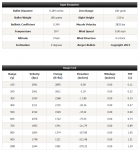You know what, you are both correct! The ambiguity of the question is what allows this to be the case.
These are two more precise questions that will illustrate:
- After the bullets leaves the muzzle, does it ever rise above the plane at which the muzzle is pointing?
The answer is No. This is the question Butch answered and he is correct.
- After the bullet leaves the muzzle, does it ever rise further above the ground than the height at which it leaves the muzzle?
The answer is Yes. This is the question marine52 answered and he is correct.
The key is to make the question explicit and specify 'rise relative to what?'.
Relative to the plane at which is fired - No - because of gravity
Relative to the ground - Yes - because of launch angle
Thanks. I believe this clarification is correct. however, there are many shooters who believe that the bullet is “falling” the instant it departs the muzzle. This is only true in the trivial classroom exercise of a barrel pointed horizontal to the earth’s surface. If the bullet started it’s fall immediately after muzzle departure then the gravitational acceleration factor g (32.17 feet per second per second) would mean that it would be falling faster and faster every second by the g acceleration. However, at departure the bullet has a positive vertical velocity. It is true that gravitational acceleration is acting on the bullet to slow its upward vector and this downward acceleration acts to decrease the bullet’s positive verticle velocity until it reaches the max ord, where, for a brief moment, the verticle velocity is zero. At that point the bullet starts it’s decent at the g acceleration rate.
It is noteworthy to remember that the max ord also corresponds to the midpoint of the time of flight (TOF). This is a simple HS class physics problem of an object thrown up and in free fall. the total TOF of the object thrown straight up will equal twice the time it takes the object to reach its high point, discounting any air resistance, which is reasonable with a projectile or object thrown 10 to 30 feet up
Last edited:












